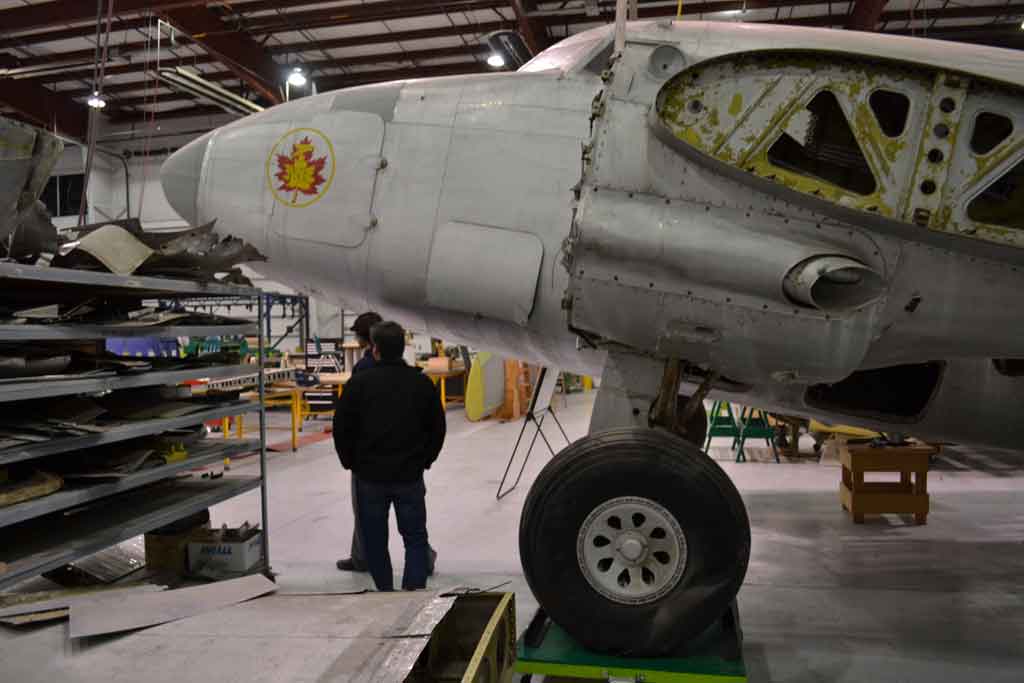By Simon Grant (Contributor) – Email
Print Edition: January 14, 2015

UFV’s Aerospace Centre held an open house last Wednesday to promote its aviation structural technician certificate program.
UFV instructor Wally Gallinger presented a program overview for potential applicants. The program consists of 14 modules teaching students plane and helicopter repair, custom parts-fitting, damaged parts repair, and parts assembly.
Other certificate programs usually take 36 months to complete, but UFV’s program is 11 months because it emphasizes kinesthetic training rather than relying solely on classroom theory, giving the students hands-on work experience before they finish the course.
Director of applied and technical studies Rolf Arnold gave a tour of the UFV Aerospace hangar.
The Cascade Aerospace hangar also houses a Lockheed Lodestar from the 1940s, which flew former Prime Ministers Louis St. Laurent and Lester Pearson roughly 60 years ago. It was salvaged from an aircraft in Chicago, and was later brought to Delta before being transported to Abbotsford, where students work on restoring it.
A Boeing 737 fuselage stands outside the hangar for course training. It belonged to a Hawaii fleet that “became a flying convertible when the top [of the fuselage] ripped off the first 12 rows of the plane midflight,” Arnold said. That incident led to an industry-wide shift in aircraft maintenance policy, he explained: “Lessons are always learned. We learned to do maintenance not by hours flown but by flight cycles. Plane parts expand and contract with temperatures and pressures from changes in altitude.”
The hangar also has a dummy rocket used in Night at the Museum: Battle of the Smithsonian.
The program also teaches students how to service wooden planes. Though the aviation industry now relies almost exclusively on aluminum and carbon fibre for plane structure, Arnold noted that students still must learn how to repair wooden plane structures.
“Though students may never come across a wooden plane in their career,” he explained, “wooden planes still fly.”
UFV instructor Al Behmer gave a demonstration on structural repair using rivets, where a technician bores a hole through a sheet of metal about to be attached and fits the rivet through. They then use a rivet gun, or pneumatic hammer, to drive the rivet against a thick metal block called a bucking bar held by a second technician. This causes the rivet to form an ‘H’ shape preventing the rivet from falling out. To further fuse the replacement piece to the aircraft, a chemical heat treatment is given.
Behmer is also working with the Chilliwack 147 Airwolf Royal Canadian Air Cadets squadron to build a dummy plane.
He says this is to teach cadets “basic structure types and materials used to construct planes,” and once completed the plane will become a flight simulator to teach cadets plane controls and plane marshalling.
The aviation field has seen many technological changes, but according to one speaker, it has lagged behind in equal representation.
Kirsten Brazier, a pilot and the founder of the non-profit organization The Sky’s No Limit – Girls Fly Too, stated that of the “24,505 total personnel in the industry, only 1300 are women.” While the organization’s primary goal is to bring women into the industry, Brazier says “men are welcome. This is not an exclusionary thing.”
Some participants left the open house with a rivet piece, while others left with a keen interest in the most integral part of flight: ground maintenance. Though the position is not as romantic as a pilot flying the plane, the work of the structural technician allows the plane to leave the ground.


